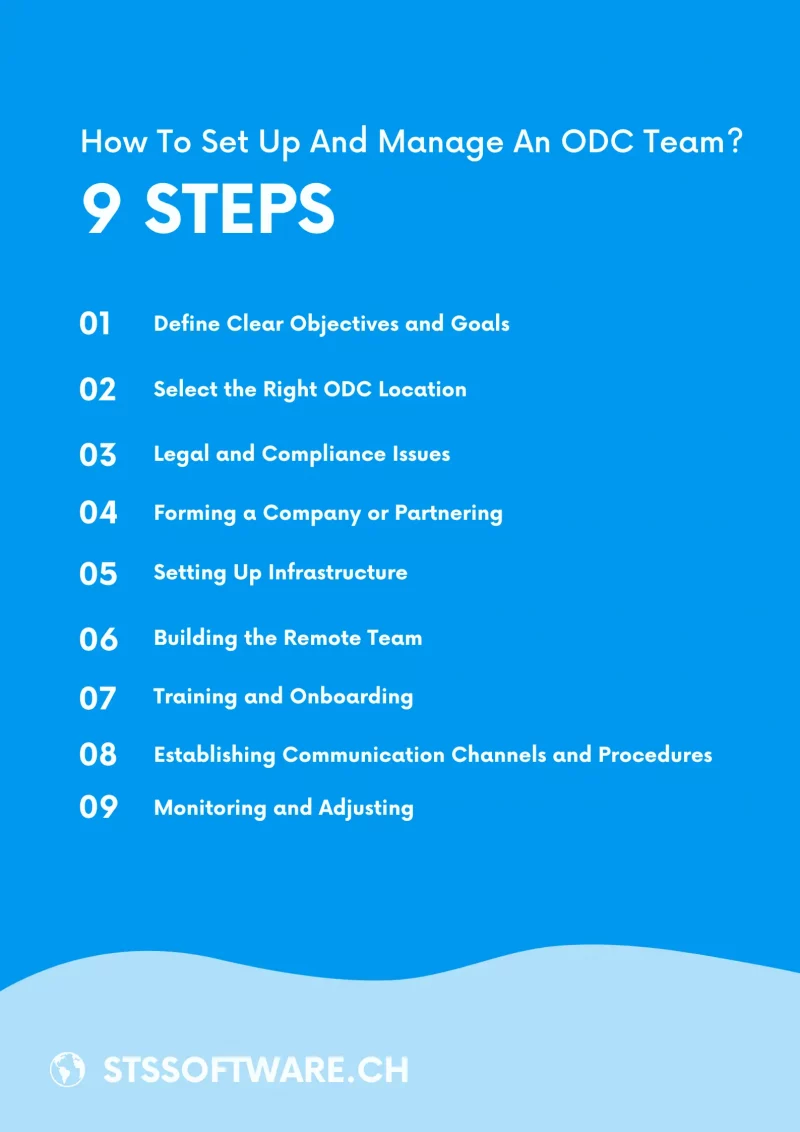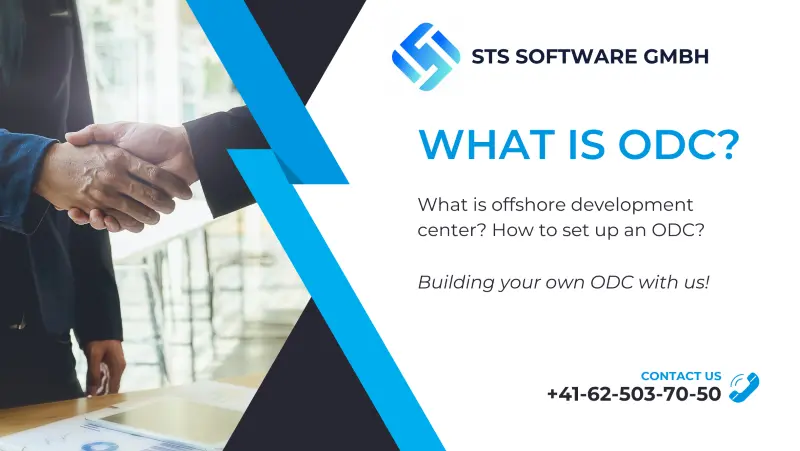Offshore development center setups are becoming increasingly popular among businesses worldwide. According to Statista, the revenue in the IT Outsourcing market is projected to grow at an annual rate (CAGR 2024-2028) of 10.99%, resulting in a market volume of US$777.70 billion by 2028. Additionally, global IT spending is expected to reach a staggering US$5 trillion in 2024.
One of the most significant benefits of setting up an offshore software development center is cost savings. Offshore software development allows businesses to access IT experts in other countries with lower labor costs. This way, they can optimize their investments without sacrificing quality.
Today, STS Software GmbH will explore the purpose of offshore development centers (ODCs) and their roles in satisfying business demands. You can also learn about their pros and cons. Ultimately, you will be able to find a perfect ODC partner for your upcoming software development project. Ready to uncover the secrets of ODCs? Let’s dive in!
What Is An Offshore Development Center?
An offshore development center (ODC) is an extension office of a development company. Despite working in a different country, the ODC is still invested in office equipment, infrastructure, and amenities.
According to offshore development center meaning, the ODC must follow the parent company’s policies and rules. The cross-functional team sticks to the fully managed processes to maintain the core business goals. Before digging deeper into ODC, let’s check a breakdown of this interesting model:
- Purpose: OCD aims to reduce expenses and offer scalable technological resources.
- Management: The parent company allocates project managers to supervise its OCDs. The managers are in charge of connecting offshore team members and business leaders.
- Team structure: The team composition varies from business to business because of its different demands. Generally, an ODC consists of project managers, team leaders, developers, software engineers, UI/UX designers, QA engineers, and relevant administrative roles.
- Benefits: Aside from the primary purpose of cutting down expenses, OCD can help with data security and scalability. Moreover, offshore development center will give you more time for your core business activities.
- Applicability: You can outsource your software development project to facilitate quick scaling and expand your influence globally. Thus, it’s suitable for companies of all sizes and industries, including IT, software, fintech, and ecommerce.
How Does An Offshore Development Center Differ From Outsourcing?
Many people are confused between an offshore development center and software outsourcing. However, they refer to different models.
ODCs, located in a different country, provide products or services. On the other hand, software outsourcing is a service that comes with certain products and services from an external company. Geographical location may not be an important factor for outsourcing.
Besides, ODCs and software outsourcing have different purposes. The ultimate goal of ODCs is to reduce costs by using the cost differences between two countries. Meanwhile, software outsourcing aims to optimize productivity and allocate more time to other important tasks. Outsourcing also helps save costs, but it is not the most crucial cause. Here is a complete comparison table between those two models:
| Offshore Development Center (ODC) | Outsourcing | |
| Ownership and Control | The parent company retains control and ownership over the operations. | Clients give direct control over the service provider. |
| Engagement | Mostly long-term engagement with ongoing development and support. | Depending on the contract, which can be short-term projects or ongoing partnerships. |
| Resource Allocation | The parent company allocates resources smoothly into their business structure. | The outsourcing company provides services for individual projects and shares resources when needed. |
| Risk and Responsibility | The parent company is responsible for risks. | Clients manage risks with the help of the service provider. |
| Strategic Alignment | The parent company sets clear goals for the ODC to follow. | Many factors, such as cost and time, come into play. Hence, the result may not be closely aligned with the overall strategy. |
ODCs and outsourcing models offer specific benefits for your business. So, when to choose which?
The ODC model is better if you need dedicated and long-term engagement for your project. It also allows for more control and ownership over the process, making it feel like an in-house team.
On the other hand, outsourcing is ideal for short-term projects where you can easily give tasks to an external company. However, this model may not provide the same level of control and commitment as an ODC.
Types Of Offshore Development Center (ODC) Models

Businesses can choose from different types of offshore development centers, including captive, vendor-based, build-operate-transfer, and dedicated models.
Captive Offshore Development Center (ODC)
In this model, the parent company sets up an ODC in a foreign country and has full control and ownership over its operations. The offshore company can help perform specific tasks, such as IT support and business process outsourcing.
Pros:
- The parent possesses the maximum control over the ODC’s infrastructure, workforce, and processes.
- The ODC directly aligns with the parent company’s culture, standards, and business goals.
- This model helps save costs in the long run and increase ROI, especially when working on large-scale and ongoing projects.
Cons:
- The initial investment is high because the parent company has to invest in infrastructure, management, and staffing for the software development company. The ongoing operational expenses increase the total cost.
- The parent company must have expertise in international regulation, local business practices, and legal compliance when setting up a company in a foreign country.
- This model is less flexible and scalable than the vendor-based.
Vendor-Based Offshore Development Center (ODC)
In this model, a company collaborates with an offshore development company to set up a dedicated offshore development center. The service provider then manages the OCD’s staffing and operations based on what the client requires.
Pros:
- The vendor is responsible for most of the management and set-up expenses. Thus, clients can reduce operational and upfront investment costs.
- Clients can access specialized expertise, infrastructure, and resources delivered by the vendor.
- Resources and team size are flexible according to project needs.
Cons:
- This model doesn’t offer companies as much control over operations and processes as captive OCDs.
- Working with offshore development teams comes with culture and language barriers.
- The project’s progress and reliability depend on the vendor’s performance and adherence to service agreements.
Build-Operate-Transfer (BOT) Model
This model is similar to the vendor-based one as it involves partnering with an offshore software development company to build an offshore development center. However, the ownership and management, in this case, goes to the client.
Pros:
- The investment risk is lower than that of the captive ODC.
- Clients can take advantage of their partners’ expertise to set up and manage offshore operations.
- This model ensures a smooth transition to full ownership while reducing risks.
- The project is aligned with clients’ objectives.
Cons:
- Both parties have to negotiate and manage the complex transfer phase, which includes multiple factors, such as finance, legal, and operational considerations.
- The transition phase may also encounter disruptions that affect the project’s productivity and performance.
- Compared to the captive ODC, this model gives less control and customization in the initial build and operation stages.
Dedicated Development Team (DDT) Model
The dedicated development team, or extended team model, means hiring dedicated developers from an offshore development center company. Then, as an extension of the client, the offshore development team works on its projects and operations.
Pros:
- This model allows for increased flexibility as companies can scale their dedicated teams up and down depending on their project requirements.
- Clients can access specialized skills without hiring permanent employees or building infrastructure.
- Clients still have complete control over the project.
Cons:
- Clients rely on their offshore software development center’s ability to ensure their project’s stability and quality.
- If the dedicated teams have members from different time zones, there will be challenges for coordination and communication.
- The dedicated team will find it harder to integrate into the client’s culture, workflows, and internal processes than captive ODCs.
What Are The Benefits Of Setting Up An Offshore Development Center?
Building an ODC yields a wealth of benefits to your businesses. For example:
Cost Savings
First, you can set up an ODC in an offshore location with low labor costs. Compared to onshore software development, offshore solutions are generally more affordable.
Moreover, since the ODC can work independently while sticking to your business goals, you can reduce costs in hiring and training your staff. This model also eliminates the need for IT infrastructure investment.
Advanced Technologies
An offshore development center opens doors to advanced technologies. You can leverage your ODC’s expertise to grow your business if you choose offshore companies in tech hubs.
For example, in 2021, more than half of companies in D-A-CH used or were going to use machine learning. More than 45% of them chose intelligent process automation. These two technologies were impressive achievements in local businesses, making D-A-CH among the best locations for offshoring.
Access to the Global Talent Pool
Setting up an offshore development center gives you access to a vast talent pool. You can work with experienced IT professionals from around the world to handle your software development processes.
You can also win the best of both worlds by hiring talent in a country with an affordable labor rate. For instance, the average hourly rate of software developers in Switzerland is CHF 57. When working with them, you can reduce the cost of hiring professional developers without breaking the bank.
Scalability and Flexibility
Depending on your project requirements, you can easily scale offshore development teams up or down. Even when your business fluctuates, you can quickly adapt to the changes.
Enhanced Focus on Core Activities
Once you’ve succeeded in setting up a stable ODC, you can free up your business’ resources. You will then have more time for your core business activities and strategic initiatives.
Faster Time to Market
Your ODC works in a different country which may have a different time zone. So, when you are asleep, your offshore team is still working. This way, you can ensure an around-the-clock operation and accelerate time to market.
Risk Mitigation
Setting up an offshore development center helps you reduce the risk related to staff shortage, finance, legal issues, and budget. When a mishap occurs, you can also share the risks with your partner. Moreover, since your team gathers top talent, you can be confident with a low-risk and error-free product.
Quality and Consistency
Your chosen offshore development center provides standardized project management methodologies, development processes, and QA procedures. The powerful team indeed offers a high level of consistency and quality.
Global Presence and Market Expansion
Working with partners in a different country assists you in gaining local insights, modifying your products, and establishing a deeper relationship with your customers. There will also be more chances for market expansion.
What Are The Risks And Challenges Associated With Offshore Development Centers, And How Can They Be Addressed?
Having an ODC by your side provides many benefits. However, you should be aware of potential risks and challenges on your way.
Communication Barriers
Since your ODC is located in a different country, you will encounter language barriers, confusing communication styles, and time zone differences. To solve these problems, you need to ensure stable communication channels. Also, set up frequent meetings so your in-house and offshore teams can be on the same page.
Quality Control
Ensuring robust quality assurance processes across different teams is tricky. You need a meticulous plan for coding standards, quality metrics, and testing methodologies. Then, monitor the processes regularly to guarantee everything is on the right track.
Data Security and Intellectual Property (IP) Protection
When managing an offshore team, you may feel stressed about keeping your data secure. Data security and IP protection failure may lead to data vulnerability, breaches, and unauthorized access.
It would be best to perform a complete risk assessment before starting your ODC. You should also sign detailed NDAs with your offshore partner and build a local database for your project. These solutions can help ensure data sanctity.
Dependency on External Partners
You surely want an excellent team to handle your software development project. However, if they perform poorly, you will face the risk of vendor lock-in. Hence, too much dependency on external expertise is not a good idea.
The best solution for this issue is to choose your partner carefully. Additionally, establish clear agreements that outline project metrics, expectations, and deliverables. Finally, stay engaged in the project to ensure alignment with your goals and address potential problems soon.
Legal and Compliance Risks
Another challenge when setting up an ODC is about compliance with industry standards, such as GDPR and HIPAA. So, ask your partner to stay informed about any changes and updates to the relevant laws. If necessary, you can provide comprehensive compliance training programs for your staff.
Cultural Differences and Work-Culture Alignment
This problem comes up in every offshoring partnership. You can deal well with cultural differences and work culture alignment by providing clear communication channels and promoting cross-cultural collaboration. Plus, encourage your staff to get used to flexible and remote work hours.
Technology and Infrastructure Limitations
The whole project will be affected if your offshore partner fails to provide advanced technologies. In this case, you can research the technology infrastructure at your location and your ODC’s site. Then, invest in necessary upgrades to ensure your team’s performance.
Where Are Offshore Development Centers Commonly Located?
Offshoring is excellent for expanding your business, but where should you go offshore? Here are the best options:
Asia
Asia is an ideal destination for those looking for low labor costs and skilled IT professionals. Many Asian countries have high English proficiency levels to ensure seamless communication between clients and offshore teams. The best places for ODCs in this area are:
- Vietnam: This country is growing as a top location for setting ODCs. The young, tech-savvy workforce offers a competitive advantage in terms of cost-effectiveness and skilled developers.
- India: India has been a powerhouse in the IT and outsourcing industry for a long time. By partnering with an Indian vendor, you can access a pool of highly skilled tech professionals and a mature outsourcing ecosystem.
- China: The growing tech industry and large talent pool make China an attractive option for ODCs. This country applies cutting-edge technologies to provide chances for market expansion.
- Philippines: The Philippines is another fantastic place for ODCs. With a skilled, English-speaking workforce, the country can deliver excellent communication channels and high-quality services.
Eastern Europe
This area is popular for its skilled and well-trained workforce. They also stick to high standards and best practices in software development. Another advantage of Eastern Europe is its location. Located near America and Western Europe, they can allow for time zones and cultural alignment. The top choices in this area include:
- Poland: The country offers a friendly tax system and business environment. Polish developers are highly proficient in many technologies. Their impressive English skills are another plus.
- Ukraine: This country provides more than 50,000 IT graduates each year to fuel business innovations. Companies worldwide also love Ukrainian developers for their competitive hourly rates.
- Belarus: Many innovative companies gather here. The talented workforce and government support for the IT industry give the country competitive advantages.
Latin America
Located close to North America, Latin America is a fantastic option for companies in the USA and Canada. Despite not offering low-cost services, the area is still famous in the outsourcing industry due to its technology background and vast talent pool. Here are some options to consider:
- Mexico: Revenue in the IT outsourcing market in Mexico is predicted to reach $5.06 billion in 2024. With a growing tech industry and competitive costs, this country offers an excellent environment for setting up ODCs.
- Brazil: Brazil is a leading destination for ODCs in Latin America owing to its robust tech ecosystem and diverse talent pool. Its expertise in software development ensures exceptional solutions for businesses.
- Argentina: The favorable business setting and qualified workforce have brought Argentina to the list of top countries for ODCs. Free tech education is another strong attraction.
How Much Does It Cost To Setting Up And Maintaining An Offshore Development Center?
The costs for setting up and maintaining an offshore development center depend on various factors, such as:
Personnel Costs
Personnel costs include salaries, benefits, and bonuses for every member of the team. The cost varies based on location, experience, and skills of the workforce. You should also consider hiring and training costs.
Infrastructure Costs
You may need to rent an office for your team. Then, equip it with computers, internet, and other IT infrastructure. Security systems and licenses also add to the fees.
Administrative Costs
Administrative costs encompass legal fees, accounting, local taxes, and relevant regulatory fees in the offshore country. You need them for risk management.
Coordination and Communication Costs
Communication is key to your success. Thus, you have to pay for communication tools, such as video conferencing software or platforms. Sometimes, you need to travel to an offshore country and execute training sessions, which increases the expenses.
How To Set Up And Manage An ODC Team?

Setting up an ODC team offers many opportunities for business growth. Let’s go through the checklist for building and managing your offshore development center efficiently.
Step 1: Define Clear Objectives and Goals
Start by outlining your goals, objectives, and deliverables for your team. Then, evaluate your project on the following aspects:
- Practicality
- SWOT (Strengths – Weaknesses – Opportunities – Threats)
- Resources
- Success prospects
- Scope and budget
- Product’s features
- Integration
Step 2: Select the Right ODC Location
Next, research potential locations based on technical expertise, culture, location, living costs, education, internet connectivity, English proficiency, and currency volatility.
Soft skills are critical, too. Partners with excellent communication and problem-solving skills will help you grow and overcome challenges easily.
Step 3: Legal and Compliance Issues
Legal and compliance issues are complicated. So, you need to consult legal experts for this step. Moreover, since you partner with a foreign company, learn about local regulations, too. Remember to focus on data privacy, tax, and employment laws when penetrating a new environment.
Step 4: Forming a Company or Partnering
After that, choose between building a dedicated offshore development center ODC or working with an established vendor. It would be nice to list potential partners first, then compare them based on these factors:
- Working culture
- Experience
- Quality
- References
- Track records
- Flexibility
- Market reputation
- Communication
- Technical expertise
- Cost
Step 5: Setting Up Infrastructure
Once you have chosen your partner, you can set up infrastructure for your offshore development team. This step involves building office space equipped with necessary facilities like:
- Office space
- Hardware and software
- IT systems
- Power supply
- Internet connecting
- Security measures
- Backup systems
Step 6: Building the Remote Team
The office is ready! Now, you need to recruit developers for your team. So first, create job descriptions to seek talents. Once you have candidates, interview them to learn more about them and analyze their qualifications, education, soft skills, hard skills, and alignment with your company culture to choose the best match.
Step 7: Training and Onboarding
In this step, you need to develop training programs to onboard new team members. The ongoing session includes these tasks:
- Welcoming new employers to help you understand their roles and company culture.
- Conducting coaching sessions.
- Mentoring and holding feedback meetings to encourage self-development.
- Solving cross-cultural issues.
- Ensuring adherence to company goals and standards.
Step 8: Establishing Communication Channels and Procedures
Communication tools allow for seamless coordination. You can communicate with your team via email, video conferencing, or email. Project management tools like Asana, Trello, and Jira are also powerful assistants.
Step 9: Monitoring and Adjusting
Your task doesn’t end even when the team has been built. After setting up your ODC, you need to monitor team effectiveness, check performance metrics, and track each team member’s productivity. Also, deal well with bug fix turnaround times, burndown reports, and velocity charts to ensure your team’s productivity. If needed, adjust your processes for continuous improvement.
Best Practices For Selecting A Partner For Offshore Development Center Services
Choosing the right offshore software development center is the most critical step to accessing top-notch services. So, how can you pull it off? Here are the best practices to follow:
- Define your requirements: Outline your project requirements to have a clear idea of what you need from your partners.
- Evaluate experience and expertise: Look for potential partners with extensive experience in providing ODC services. You can check case studies and past projects to see their expertise in relevant industries.
- Assess technical skills: Review their certifications and skill sets to ensure they have expertise in your favorite programming languages and frameworks.
- Consider cultural fit: Assess if your partner’s work culture is aligned with your business to guarantee effective collaboration.
- Check references: Find references and reviews from past clients to get insights into their performance and reliability.
- Evaluate communication channels: Examine your partner’s communications and responsiveness. You need timely updates and interaction for your success.
- Review contract terms: Review the terms and conditions in the contract carefully. The most important things to pay attention to are pricing, IP rights, and payment methods.
Success Stories Of Companies Leveraging Offshore Development Centers Effectively
STS Software GmbH has more than ten years of experience delivering top-notch ODC services. The case studies below highlight our expertise and skills to drive client success.
Merit Logistics ODC
Merid Logistic ODC wanted to upgrade its outdated ERP system, which included various modules, such as salary management, customer management, bill management, and more.
STS Software GmbH divided this project into three stages. First, we conducted thorough analysis to understand the existing systems and business rules. Then, we enhanced its performance by improving some features and made a new system with new technologies. Finally, we created an application to facilitate salary management.
Thanks to our help, Merit Logistics can transform its system with improved performance and interfaces. Our three-stage approach incurred seamless transition and minimal description.
Mobile Team Manager
Mobile Team Manager asked for a cloud-based solution for traffic management operations in Australia. They also needed interactive scheduling screens for mobile apps.
To help our clients, we focused on building an MVP with essential features and improved it as we got feedback. Then, we developed a powerful app to enhance user experience. STS Software GmbH was proud to build a robust software platform that is now widely used across industries worldwide.
Triptomatic
Booqit, a startup from Belgium, required a cross-platform system to streamline their medical transport bookings. The system should be able to cover invoices, vehicles, transports, and a chat platform.
STS Software GmbH carried out this project by building a comprehensive system. We first gathered a team of experienced developers and a project manager. We focused on infrastructure design and then adding new features. Communication with the client was also our priority.
Finally, we successfully developed a robust Triptomatic system that met all Booquit’s requirements for efficient transport management. We also integrated APIs so the app can work smoothly with other systems.
Why Choose STS Software GmbH Gmbh To Set Up Your Offshore Software Development Center?
STS Software GmbH GmbH is a leading offshore software development company in Switzerland. Once you’ve chosen us to build your own offshore development center (ODC), you can get benefits from our:
- Cost-effective services that maximize values in your investments.
- More than ten years of experience in software development
- More than 250 IT professionals, including skilled software developers, QA experts, and project managers.
- ISO certifications that reflect our commitment to quality and customer satisfaction.
- Advanced technologies, such as AI and ML, help you stay ahead in the dynamic competition.
FAQs
How do I know a dedicated offshore development center is the optimal choice for our company?
The dedicated offshore development center is your best choice if:
- You have long-term software development needs.
- You seek more control over the development process.
- Cost savings are among your top concerns when handling software development projects.
- You want to access more talent and specialized skills on a global scale.
What pricing models are available for setting up an offshore development center (ODC) with your services?
You can choose from these three options:
- Fixed-pricing model: In this model, you and your partner agree on the budget, objectives, and timeframe of the project first. Then, you pay for all the deliveries. So, the model works best for those with clear needs.
- Dedicated development team: This model provides a high level of flexibility as your dedicated team integrates into your company.
- Time and material contract: If you have ever-changing demands or ambiguous scope, go for this model. You only pay for what you exactly get.





